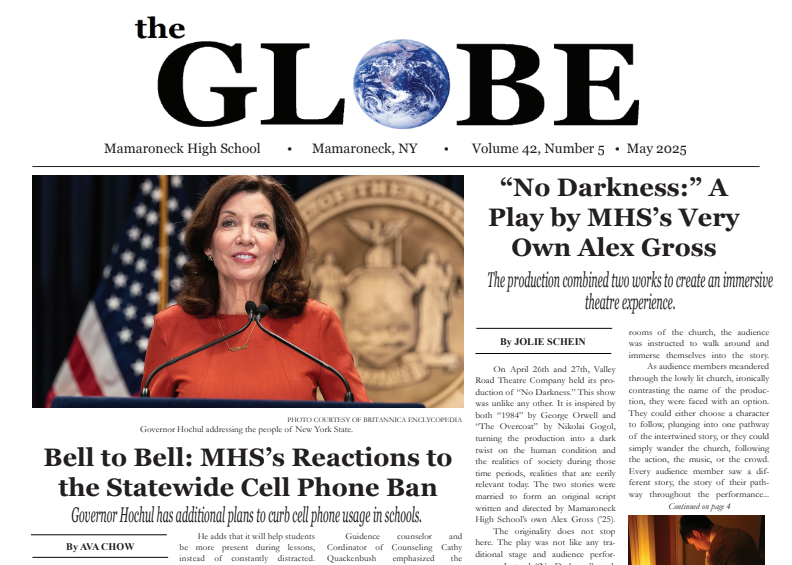MHS Needs Better Climate Education
The climate crisis is here and already threatening all of our futures, but for most MHS students, their education barely mentions it.

People from all over the world join forces to help the planet face the climate situation.
February 28, 2022
Climate change is undoubtedly one of the most substantial problems our world will have to tackle this century. From California’s wildfires to the melting of ice caps in the Arctic, we have already seen drastic and irreversible effects around the globe. And the science shows that if we carry on in a “business as usual” fashion, within a few decades, no one will be safe from the worst effects of the climate crisis. Climate change is an issue that every citizen of the world has a responsibility to be educated about, and high school, as one of the most important stages in a student’s formal education, is the perfect place for students to begin learning in-depth about this extremely consequential issue. Yet Mamaroneck High School’s curriculum is clearly lacking in the study of climate change.
There are currently only two classes at MHS in which students are supposed to be learning about climate change: 9th Grade Biology and AP Environmental Science. However, in a poll of 50 random MHS seniors, only 2 actually had a strong memory of learning about climate change in their freshman year biology class, while 19 barely remembered learning about it and 29 didn’t remember learning about it at all. This suggests that some freshman biology teachers might not even be covering climate change, and for the ones that are, they are not doing so in a memorable way. The freshman biology curriculum could benefit from being edited so that students’ first high school engagement with the topic is more meaningful.
Conversely, AP Environmental Science is the ideal course for students to learn about climate change. Up to 20% of the Environmental Science AP Exam multiple-choice section focuses on climate change, and other units, such as one on biodiversity, require discussion about climate change. Evidently, a significant portion of the curriculum is dedicated to the study of climate change, and AP Environmental Science likely fosters a meaningful climate change education experience for most of the students who take it. However, the reality is that as of right now, it is only offered to seniors, and students must choose to take it over a variety of other science courses. This means that some students at MHS aren’t able to embark in worthwhile study of climate change until their final year of high school, while others don’t at all.
There are, of course, many options that MHS can take to extend its students’ access to climate change education, but here are some of the changes that I believe would be the most effective. First, taking into account MHS’ current AP policy, which only allows students to take APs as juniors and seniors, AP Environmental Science should be added as an option for juniors. Jen Novick (‘22) is someone who, through her involvement in MHS Eco Reps as one of the club’s presidents and enrollment in AP Environmental Science, has taken advantage of all of the school’s offerings related to climate change education. Despite this, Novick still comments, “My experience learning about climate change at MHS has been disappointing”, adding that “[I] constantly feel like I am behind and not knowledgeable enough to speak on the topic of climate change.” She believes that maybe if she had “begun this educational journey earlier”, she might not feel this way. Additionally, due to the fact that many seniors are accepted to college before the end of the year and a good portion are accepted before January through early admission, senior year is not the time of peak education engagement for students. Therefore, the current restriction of the course to seniors prevents students from potentially being inspired to take their own actions in combating the climate crisis (such as getting involved in environmental activism outside of school or making more eco-friendly choices) at a time when they are much more engaged with the content they are learning. Of course, before this change can be made, it could be a good idea to determine whether there is significant interest among juniors in taking this course. However, if there is, there is no reason for the administration to withhold this opportunity from juniors.
Secondly, MHS should require that its students take an environmental science course at some point in high school. I am aware that not all students can handle an AP-level course, which is why I think MHS could benefit from adding a standard environmental science class. While the two required science courses at MHS, Biology and Chemistry, are important building blocks in one’s study of science, they arguably don’t hold the same relevance to the modern high schooler’s future as environmental science does. If creating a new environmental science class and making the appropriate adjustments in staff proves to be too difficult an endeavor, an alternative would be to revise the 9th grade biology curriculum to ensure that students are spending the necessary time learning about climate change. Something that has been so catastrophic to our world already and will directly impact the futures of this generation of high school students cannot be simply brushed over. It’s unacceptable that some students will graduate from MHS with less than satisfactory knowledge on this topic.
Another change to the curriculum that would benefit MHS students is if they were able to learn about climate change in the non-science courses that MHS has to offer. MHS’ AP Environmental Science teacher, Sophia Andrews, is a big proponent of this idea, as she believes that “Climate change education is interdisciplinary by nature so there are ways to embed these concepts naturally into pre-existing courses and courses created in the future.” This could look like discussing environmental policy in AP Gov or Current Issues in Law & Government. Global History classes could cover the impacts of climate changes on past civilizations and also the relevance of the Industrial Revolution to the crisis we are facing today. It is extremely important for high schoolers to be aware of the fact that climate change is an interdisciplinary issue, and as such, that’s something that should be reflected in their school’s curriculum.
One might argue that students who aren’t enrolled in an environmental science class may still be able to self-educate on climate change, but this issue is too significant to entrust kids with voluntarily deciding to learn about it. Andrews agrees, explaining that, “Learning about climate change can be difficult on your own, without formal guidance from a teacher and without the benefit of learning alongside your peers.” Students may be able to have a fruitful experience when they do their own research, but there is, without a doubt, a component missing from this experience that can only be found in a classroom environment.
We are at a point where educating students, particularly high schoolers, about climate change is something that we can no longer cast aside or neglect. All of these changes would better reflect the urgency of the crisis we are being faced with. As Novick says, “To learn about climate change is to value the current and future state of the planet and its inhabitants. No change can come from ignoring the problems at hand.”





